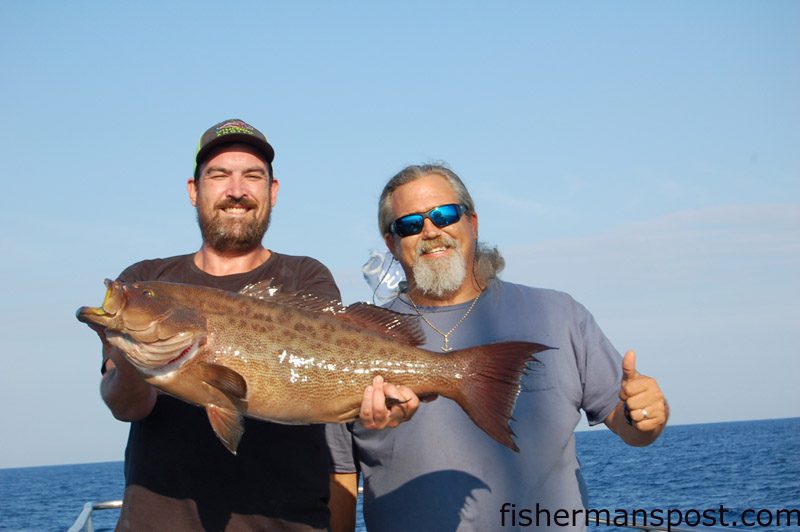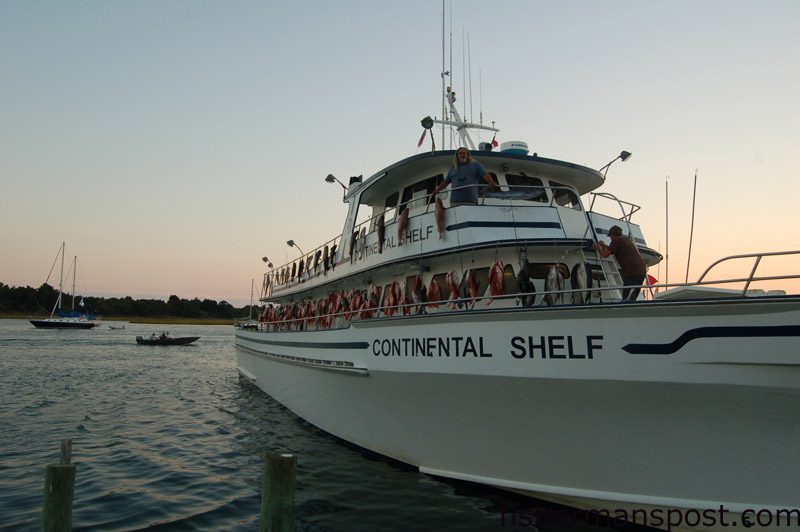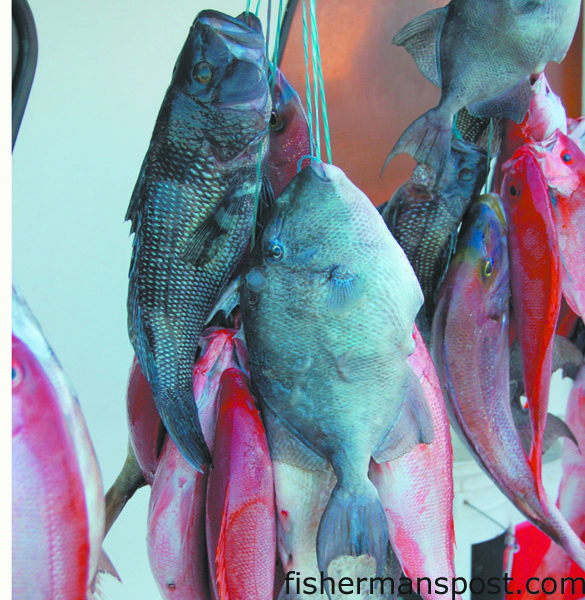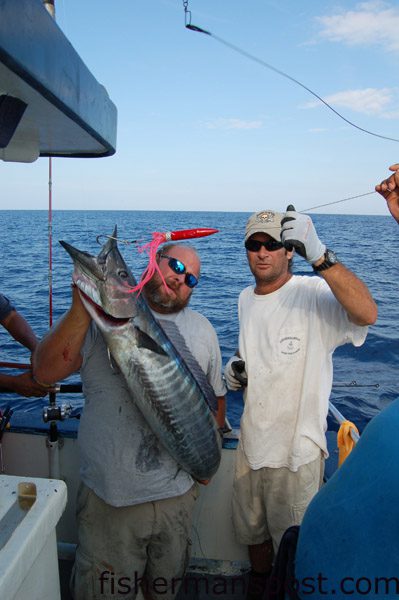Guide Time – Bottom Feeders Lookout

The author and Capt. Dave Tilley, of the “Continental Shelf,” with a yellowmouth grouper that fell for a cut bait/squid combo at some bottom structure in 200′ of water east of Cape Lookout Shoals.
Crossing Beaufort Inlet as the sun melted beneath the hotels and houses of the beachfront, the 100’ “Continental Shelf” didn’t even raise her bow to greet the widely-spaced 1-2’ waves rippling the surface of the Atlantic. Soon only lights were visible as the big headboat chugged south, and presently they, too, faded, replaced by the glow of the stars and a faint slice of a nearly-new moon.
It would be two full days before the 25 anglers and seven crew about the ‘Shelf would see land again, as sunset marked the dawn of the 48-hour double overnight, the hardcore, big-boy trip of south Atlantic headboat fishing.
After missing a pair of these trips last year and one earlier in the summer due to work and weather, I was thrilled when I saw Capt. Dave Tilley’s number pop up on my iPhone with a short-notice invitation for the excursion.
“The forecast couldn’t be better and we’re going to slay them,” Tilley exhorted.
I’d have accepted on the spot, but had to make another phone call to the boss to make sure I could break away from Fish Post duties (and phone accessibility) for the end of the week. This call, too, went better-than-expected, and I was ringing Tilley back to sign on in moments.
Thirty-six hours later, I was listening to the captain’s speech as the bottom fishing battlewagon’s three motors warmed up.
Along with life jacket locations and other safety cautions, Tilley vehemently encouraged our crew to rest while running out and between stops, as no one wants to succumb to sleep during a hot bite.
As I would later realize, it was good advice, but the lure of downing a few beers as we cruised over slick-calm seas won out. I also used the time to get acquainted with some of the crew and fellow passengers aboard. Many, perhaps most, of the anglers on the trip were from the midsection of the Old North State, but a sizeable contingent had come from farther up the eastern seaboard, as Virginia, Delaware, and New Jersey were all represented. Roughly half the boat were newcomers like myself, the remaining portion ‘Shelf veterans on a first-name basis with the crew.
Tommy, Danny, Joe, and Tilley’s son Zach were our mates for the trip, with Milton manning the grill and fridge behind the cabin’s galley bar. These 48-hour trips were added to the Continental Shelf schedule last year, and with this only the third one, crew and anglers alike were excited to see what we’d be hauling up from the depths over the next two days.
I managed to shut my eyes for the last hour of the run, first heading south out of Beaufort Inlet and then doglegging east around the sandy tip of Lookout Shoals. Eyes closed did not sleep make, and a short time later Tilley came on the boat’s loudspeaker to announce we were nearing our first drop.
“Guys, we’re fishing a big wreck out here that should have a bunch of beeliners on it,” he explained. “Reel up five turns from the bottom or you’ll be hung up every drop.”
We baited up double bottom rigs with chunks of northern mackerel and squid that the mates had sliced and divvied up on the ride out, and after the mates set the anchor, the captain gave the call to drop. Anglers following Tilley’s advice were quickly hauling the striking red-orange fish (aka vermillion snappers) over the rails in solid quantities, and most were easily above the 12” minimum size limit.
I’d taken up a position near the boat’s port midsection and joined in the beeliner action, putting several fish on deck, when I peered around front of the cabin to check out a commotion from the other side of the bow. Though grouper action at night can be extremely inconsistent, Joe had slipped a larger bait overboard and was quickly rewarded with a fat gag grouper.

Capt. Dave Tilley presides over a substantial haul of sea creatures upon the return of the 48-hour trip on the “Continental Shelf.” Stringers of beeliners, sea bass, triggerfish and other bottom dwellers along with amber and almaco jacks hang below, with grouper and a wahoo riding at bridge level.
While the beeliner bite was on, grouper envy took hold for me, and I replaced my double-drop rig with a single hook grouper rig and began dropping larger cut baits and cigar minnows in an attempt to fool my own gag.
Tilley, in what became a familiar pattern, made steady laps around the boat’s upper deck, interacting with his mates and anglers from above while taking stock of the fish coming aboard. Anglers were still hooking beeliners and other smaller fish aplenty when Dave got back on the loudspeaker to make the call to head offshore, but my big-bait drops had done nothing but reinforce the conventional wisdom on nighttime grouper action.
“We’re going to have plenty of time to catch beeliners on this trip and there should be bigger ones offshore,” Tilley said. “I’m going to run to the break so we’ll be out there for sunrise.”
He again repeated his recommendation to catch some sleep while we could, but I again found myself too keyed-up about what lay in store in the truly deep water to do more than fight to keep my eyes closed.
A yellow-gray hint of the coming dawn was coloring the eastern horizon when I opened my eyes again, and the motors slowed as Tilley made a couple laps around our next spot to get a feel for the life below and how the faint wind and current would affect the big boat’s anchor course.
Tommy and Zach were soon paying out the anchor rode as Tilley again addressed the crew.
“This is the spot where we caught the state-record scamp grouper on this trip last year,” he explained, “at sunrise. Merry Christmas!”
I’d spent a bit of time staring at the photo of that huge scamp, a 27+ lb. fish caught by Knightdale, NC’s Toby Grantham and featured on an October 2012 Fisherman’s Post cover, and keenly awaited the call to drop.
With the sun now tickling the horizon, big baits on big hooks for big fish were the only thing on my mind, and unlike our first drop, the plan proved almost immediately effective.
After losing a bait to a hard strike on the first drop, I reeled up my rig (a slightly more difficult proposition in 200+’ of water than the 110’ we’d been fishing at the first spot).
I pinned a cut bait/cigar minnow combo to the 10/0 circle hook on my grouper rig and sent it back on the long plummet to the seafloor, where it was immediately inhaled by something more substantial than a beeliner.
The circle hook connected and my heavy grouper rod was quickly bucking under the violent head shaking of some clearly displeased creature 200’ below. It didn’t quite have the bottom surging power of a grouper, and as the headshakes continued on the way up, I began to suspect that, like a pair of Concord, NC, anglers just to my left had done, I’d hooked an American red snapper. A few minutes later, a small-but-growing shape was materializing in the clear water below the boat and taking on a pink/red hue as it approached the surface, and my suspicions were proven correct as Tommy hauled the 10 lb. fish over the gunnel.
It was the largest snapper I’d ever caught, and a gorgeous and delicious fish, but due to a federal red snapper closure, it had to be released after a quick photo. Tommy and Danny were quick to vent the fish, releasing the gas it had built up during the ride to the surface (basically a reverse case of the “bends” which plague divers who surface too quickly), and the snapper shot back into the depths after they eased it overboard.
The next bait I dropped was also immediately assaulted when it touched down, and I was again locked in battle with something large and unhappy well below the boat. This fight went a bit differently, with more power but less headshakes, and a bit more lateral swimming than the dead-vertical fight of the snapper. A healthy 6’ sand tiger shark was the final reward after minutes of lifting and cranking, another neat catch but not anything to add to the fish box. In a clearly well-practiced move, Tommy reached out with a long gaff, twirled the leader around the end, and broke the circle hook off in the shark’s mouth while leaving it in the water.
The sun, now well up, and a pair of locked-drag battles from the deep structure had me sweating and shedding clothes before my next drop, but hooking up again took less time than re-tying a hook and stashing my hoodie and jeans in the cabin.
Familiar, but even more jarring headshakes led me to the conclusion this was another snapper, and indeed, when the fish came into view it was an even-larger American red pushing 20 lbs., which Tommy and Danny gingerly hauled up, vented, and sent back on its way.
Fast action with big fish is irresistible to me regardless of the rewards for the table, and despite a growing burn in my forearms, I ran my hook through another northern mackerel and sent it to the seafloor.
This bait stayed on the bottom for several long moments before I felt the thump I’d been waiting for and again reeled tight to a bowed-up, bucking rod fast to an angry bottom dweller.
Another clearly-substantial fish, this one had a different rhythm than the snapper or shark, and I grew hopeful that I’d be introducing a grouper to an icy fiberglass coffin at the end of the lengthy trip to the surface.
When I finally got a deep glance at the creature, a brownish hue led me to call for a mate, and Tommy was soon sinking a gaff into a porky grouper.

Fat vermillion snapper, black sea bass, triggerfish, and red porgies are part of the bounty available to anglers taking offshore bottom fishing trips off Morehead City on the headboat “Continental Shelf.” These fell for chunks of squid and northern mackerel on double drop rigs east of Cape Lookout Shoals.
“Nice scamp!” I shouted exuberantly as it came over the rail, but Danny, strolling by along the rail was quick to chime in.
“It’s actually a yellowmouth,” he explained, demonstrating some subtle differences in the fins and mouths between the two similar species.
A slightly less-common fish, yellowmouth grouper are every bit as delicious, and I forced Tilley to come down from his perch on the upper deck to join in some pictures of the 17 lb. fish before it hit the ice.
The captain had just returned to his supervisory role on the bridge when I heard his voice rise again.
“Max, come check this out,” Tilley shouted a moment later. “There’s a scamp back here that could eat your fish!”
Indeed, one of the anglers on the port stern had put a scamp well into the 20-lb. class in the boat, closing in on Grantham’s record fish but not quite enough to take the honor.
More big scamps, yellowmouths, and a gag were landed by anglers scattered from stern to bow of the vessel, with most hovering in the 15-20 lb. range and none anywhere close to needing a measurement before hitting the fish box.
One of the beauties of the deepwater structure that anglers get to fish on these overnight trips is the consistent quality of the fish landed, with few-to-none below minimum size limits. In fact, were it not for closures like that on the American reds and the odd shark hookup, anglers can keep the vast majority of fish caught instead of struggling to find one big enough to make length as is common closer to shore.
My final drop at the sunrise spot produced another huge hookup, but the fish rocked me up and cut my leader before I could get its head turned. The bite slowed up a bit, and after a lap or two of the topside, Tilley made the call to haul anchor and search for some more hungry fish.
The day had turned out even calmer than forecasted, and we glided over glass-calm seas as we made our way to the next spot on Tilley’s game plan. The near-zero winds made for comfortable traveling and fishing conditions, but experienced bottom fishermen realize that the comfort comes at a price. Without much wind (and with equally light currents as ruled this trip), it’s very difficult to predict what the boat will do when anchored up, making zeroing in on a small rock or drop-off a challenge at best. Combine this with the fact that several of our stops were absolutely overrun with 5-20 lb. red snappers that wouldn’t give anything else time to find the baits, and Tilley’s job proved a challenging one late that morning and early afternoon.
“Reel ‘em up guys,” Tilley said after another spate of the snappers came up on anglers’ first drops at a new spot. “I’m not going to stay here and keep catching these things.”
He struck gold (more accurately; orange) at a spot in the early afternoon, however, and from then until sunset anglers up and down both rails were treated to the best beeliner fishing I’ve ever personally witnessed.
“That’s not a beeliner. That’s an ocean liner,” was heard again and again over the course of the afternoon. Anglers were often unable to get their rigs to the bottom before 3-5 lb. beeliners attacked the baits on every drop for hours. Double hookups weren’t uncommon, and Zach, Danny, Tommy, and Joe stayed busy ferrying beeliners to fish boxes all afternoon.
Another beauty of the 48 hour trips is that they allow anglers to keep three daily limits of fish, so anglers were able to take home 15 of the massive beeliners each. The long trips are somewhat more expensive than 12 and 24-hour jaunts, but the amount of fish anglers can sock away in the freezer offsets the cost difference handily.
Triggerfish, sand tilefish, and a few other odd deepwater species like the toro were mixed in with the beeliners, and anglers also added a few fat red grouper to the box amidst the flood of the vermillion snappers.
Tilley doesn’t limit these extended Continental Shelf trips to bottom fishing, as he will pull up to weedlines to allow anglers to cast to dolphin or high-speed troll for wahoo between spots if conditions are right.
Zach Tilley, a Canyon Reels sales representative as well as mate, had just set a South Chatham Tackle high-speed wahoo lure on a Canyon EX-50 out as we made a six-mile run between spots, and within five minutes of the large lure hitting the water, the Canyon began shrieking. Joe beat the younger Tilley to the bent-over outfit at the back of the upper-deck, and after an intense 10-minute battle, Danny was sinking a gaff in a 35 lb. wahoo to add to our haul. We reset lines and made a few more quick passes over the spot, but the fish appeared to be a loner, so Dave quickly made the call to continue on to the next bottom spot. If conditions are ideal, Tilley will spend a bit more time trolling, and the high-speed lures put six wahoo in the box during one of the 48-hour trips last fall, a delicious addition to the usual headboat bottomfish haul.
I was a few fish off my limit of beeliners as the sun sank towards the sea, but had an impressive haul already before I decided to lay down my rod and petition Milton for a cheeseburger.
The action all day had been too busy to consider my lack of rest, but sitting down to enjoy the sandwich, I realized the long day of reeling on zero sleep had taken its toll both mentally and physically.

Mates Joe and Danny with a 40 lb. class wahoo that fell for a South Chatham Tackle Hoodoo high speed lure trolled on a Canyon Reels EX-50 outfit while the headboat “Continental Shelf” was trolling between bottom spots in 180′ of water east of Cape Lookout.
Approaching shut-down mode, I dropped a few more times after completing my meal, but quickly realized that sleep was a burning priority and it was time to find a spot to stretch out my substantial frame.
A poor sleeper under the best of conditions, I figured on a fitful nap of a few hours, but apparently my fatigue was more than I’d counted on. I awoke to a gentle breeze on the upper deck feeling surprisingly refreshed, which became markedly less surprising when I staggered into the cabin and realized I’d been out for over 10 hours and the sun would soon be coloring the horizon again.
Anglers had completed the boat’s limit of beeliners as I dozed, and we were chugging inshore so Tilley could search for black sea bass and other shallower bottom dwellers to add diversity and poundage to the fish boxes.
Again, a lack of predictable wind and current made anchoring the big boat a challenge, but Tilley refused to settle, anchoring and re-anchoring on some spots and drifting a few larger areas when the conditions called for it. A steady pick of sea bass, more triggerfish, red porgies, and other bottom dwellers were the rewards for the anglers below, and everyone made some solid additions to their stringers as the morning wore on.
With each stop, Tilley worked a bit closer back towards Lookout Shoals in order to shorten our eventual run home, and our final stop was another large wreck not far from the end of the shoals.
I was chatting with the captain on the upper deck as he was just about to make the call to head in when anglers landed a pair of big gag grouper from the port stern corner.
“I can’t leave a grouper bite,” he said with a grin. “Let’s give them a few more minutes.”
The few more minutes turned into around 15, and the stern crew added another half-dozen gags to our haul before the bite finally slowed and sharks took over.
After the third shark in a few short moments, Tilley was satisfied the bite was done and we made preparations for the steam home.
The full extent of our haul was made apparent as the mates hung the fish along the ‘Shelf’s starboard side while we eased back into Beaufort Inlet. Huge stringers of the beeliners, triggers, bass, and other smaller fish filled the entirety of the starboard side below, with the wahoo, grouper, and almaco and amberjacks taking a starring role along the boat’s top deck. The smorgasbord of fish didn’t go unnoticed as we pulled up to the dock, and a throng of onlookers grew along the docks as Tilley slid the big vessel gently into its slip.
With chances at a vast array of bottom feeders large, small, exotic, and common (along with three-day possession limits), the Continental Shelf 48-hour trips are the stuff of dreams for devoted bottom fishermen. Chances at wahoo, dolphin, and other pelagics aboard a big boat with plenty of fishing room and a top-notch crew make it the premiere experience in NC headboat fishing.
Anglers can learn more about the 48-hour trips and 12 and 24-hour excursions at www.continentalshelf.com.
